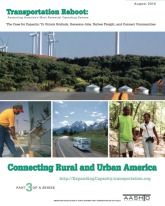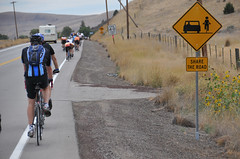On Monday, the American Association of State Highway Transportation Officials (AASHTO) — an influential group of state DOT directors — announced a report calling on Congress to prioritize funding for expanded rural highway capacity in the forthcoming re-write of the transportation bill. Spending hundreds of billions on highway projects and adding 30,000 new lane miles is sure to raise eyebrows in active transportation circles, but could AASHTO’s plan help improve biking conditions on highways across America?
Maybe.
“It could be be a boon to the USBRS [United State Bike Route System], it all lies in the implementation.”
— Ginny Sullivan, Adventure Cycling
In a statement about the new report, AASHTO Executive Director John Horsley says, “Improving connectivity for the 60 million Americans who live in rural areas is just as important as improving mobility for those who live in metropolitan areas.” Key to Horsley’s argument is that most interstate highways were built 60 years ago, and little has been done to improve or expand capacity on them since.
Here’s more from Horsley:
“… investment is needed in America’s rural transportation system to keep agriculture, new energy products and freight moving; improve access for the travel, recreation, and tourism industries; connect new and emerging cities; and to ensure reliable access to key defense installations.”

– Download here –
Specifically, AASHTO wants the US highway program to be increased to $375 billion over six years and they are calling for 30,000 new highway lane miles. The report also provided a state-by-state list of highway projects. For Oregon, the report singled out the controversial, $550 million dollar Newberg-Dundee Bypass project (which scored a $192 million earmark from lawmakers in Salem last session).
While the report has enough talk of more and bigger highways to make active transportation advocates cringe, it also advocates for rural transit service to “more than double over the next six years to keep pace with rising demand.” There’s also the question of how bicycling could benefit with smoother, wider shoulders, and more space on bridges and roads.
Given AASHTO’s support of Adventure Cycling’s U.S. Bicycle Route System, and Mr. Horsley’s familiarity with bicycling in general (he keynoted the National Bike Summit in 2008), I asked Adventure Cycling’s Ginny Sullivan if she thought AASHTO’s desires could benefit bicycling.
“It could be a boon to the USBRS,” she said, “it all lies in the implementation.”
Sullivan says the USBRS and a push for higher quality rural interstate roads share a “common goal” of linking developing with scenic destinations. Here’s more from Sullivan:
“If implementation of this rural road/highway system includes adding or expanding shoulders that are protected from in appropriate rumble stripping, then yes, this push is beneficial. I also see the potential for overcoming other barriers, such as widening bridges to accommodate bicycle passage safely and conveniently. As we both know, adding vehicular capacity doesn’t always make a friendly bicycle route, but if the rural roads initiative takes into account all users, this could be a wonderful benefit for the development of the U.S. Bicycle Route System.”
Sullivan says she’s already discussing the report with her contacts at AASHTO.
Whether you buy AASHTO’s argument for expanded highway capacity or not, at least Adventure Cycling is at the table, reminding them that their projects should not forget to include adequate provisions for bicycle traffic.
— Learn more about the USBRS here. Visit AASHTO’s website to download a PDF of the report, “The Case for Capacity: To Unlock Gridlock, Generate Jobs, Deliver Freight, and Connect Communities.”


